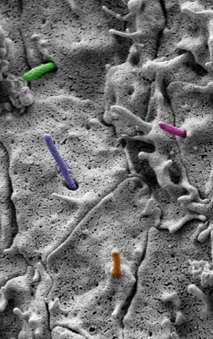SEM image of pseudocolored cilia in the developing embryo. Credit: Richard Edlemann (Center of Advanced Microscopy and Imaging, Miami University, Oxford, OH) with assistance from Ching-Fang Chang (CCHMC) and Elizabeth N. Schock (CCHMC). Psuedocoloring was done by Matt Kofron (CCHMC).
Widening across the forehead and nose occurs when loss of cilia at the surface of the cells disrupts internal signaling and causes two GLI proteins to stop repressing midfacial growth. Ching-Fang Chang and Samantha Brugmann of the Cincinnati Children's Hospital Medical Center in Ohio, US, report the findings in a study published November 1st, 2016 in PLOS Genetics.
Tiny projections, called cilia, are located on the surfaces of cells all over the body and serve an important role in cell signaling, which when lost, cause diverse diseases called ciliopathies. The midline of the face is especially susceptible to ciliopathies, and previous studies have shown that facial widening results from increases in Hedgehog signaling activity, a pathway that signals embryonic cells to direct development. However, the exact relationship between cilia loss and increased Hedgehog signaling is unclear. The scientists used mouse models of ciliopathies to investigate signaling proteins involved in this pathway, and looked specifically at the role of two proteins, GLI2 and GLI3. These proteins have both an activator form and a repressor form that regulate expression of genes in the Hedgehog pathway. When they disrupted signaling from the cilia, the mice experienced facial widening because the cells lost the repressor activity of GLI2 and GLI3 that normally keeps Hedgehog signaling in check.
The contributions of the activator and repressor functions of GLI genes to development is a complex topic that has been difficult for scientists to piece together. While the repressor forms of GLI3 and GLI2 were already known to play a role in neural tube and limb bud development, little was known about how these genes function in facial formation. These studies give insights into the mechanisms of how the cilia and GLI proteins function during midfacial development.
More information: Ching-Fang Chang et al, Craniofacial Ciliopathies Reveal Specific Requirements for GLI Proteins during Development of the Facial Midline, PLOS Genetics (2016). DOI: 10.1371/journal.pgen.1006351
Journal information: PLoS Genetics
Provided by Public Library of Science




















